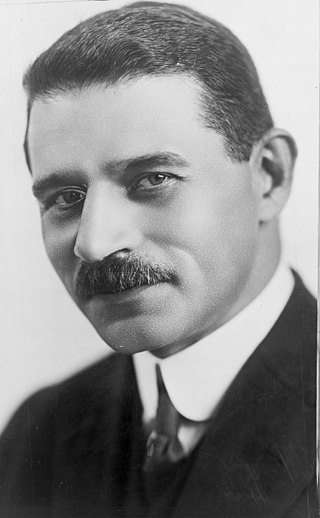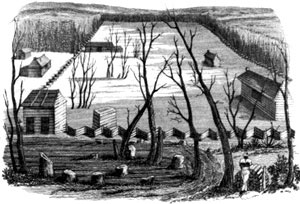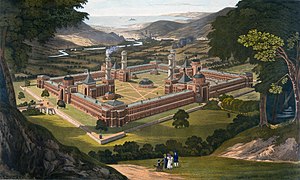
A utopia typically describes an imaginary community or society that possesses highly desirable or nearly perfect qualities for its members. It was coined by Sir Thomas More for his 1516 book Utopia, describing a fictional island society in the New World. However, it may also denote an intentional community. In common parlance, the word or its adjectival form may be used synonymously with "impossible", "far-fetched" or "deluded".

Frances Wright, widely known as Fanny Wright, was a Scottish-born lecturer, writer, freethinker, feminist, utopian socialist, abolitionist, social reformer, and Epicurean philosopher, who became a US citizen in 1825. The same year, she founded the Nashoba Commune in Tennessee as a utopian community to demonstrate how to prepare slaves for eventual emancipation, but the project lasted only five years.

New Harmony is a historic town on the Wabash River in Harmony Township, Posey County, Indiana. It lies 15 miles (24 km) north of Mount Vernon, the county seat, and is part of the Evansville metropolitan area. The town's population was 789 at the 2010 census.

Robert Owen was a Welsh textile manufacturer, philanthropist and social reformer, and a founder of utopian socialism and the cooperative movement. He strove to improve factory working conditions, promoted experimental socialistic communities, and sought a more collective approach to child rearing, including government control of education. He gained wealth in the early 1800s from a textile mill at New Lanark, Scotland. Having trained as a draper in Stamford, Lincolnshire he worked in London before relocating aged 18 to Manchester and textile manufacturing. In 1824, he moved to America and put most of his fortune in an experimental socialistic community at New Harmony, Indiana, as a preliminary for his Utopian society. It lasted about two years. Other Owenite communities also failed, and in 1828 Owen returned to London, where he continued to champion the working class, lead in developing cooperatives and the trade union movement, and support child labour legislation and free co-educational schools.

Morris Hillquit was a founder and leader of the Socialist Party of America and prominent labor lawyer in New York City's Lower East Side. Together with Eugene V. Debs and Congressman Victor L. Berger, Hillquit was one of the leading public faces of American socialism during the first two decades of the 20th century.

The Nashoba Community was an experimental project of Frances "Fanny" Wright, initiated in 1825 to educate and emancipate slaves. It was located in a 2,000-acre (8 km²) woodland on the side of present-day Germantown, Tennessee, a Memphis suburb, along the Wolf River. It was a small-scale test of her full-compensation emancipation plan in which no slaveholders would lose money for emancipating slaves. Instead, Wright proposed that, through a system of unified labor, the slaves would buy their freedom and then be transported to Haiti or the settlements which would become Liberia.

Albert Brisbane was an American utopian socialist and is remembered as the chief popularizer of the theories of Charles Fourier in the United States. Brisbane was the author of several books, notably Social Destiny of Man (1840), as well as the Fourierist periodical The Phalanx. He also founded the Fourierist Society in New York in 1839 and backed several other phalanx communes in the 1840s and 1850s. His son, Arthur Brisbane, became one of the best known American newspaper editors of the 20th century.
Owenism is the utopian socialist philosophy of 19th-century social reformer Robert Owen and his followers and successors, who are known as Owenites. Owenism aimed for radical reform of society and is considered a forerunner of the cooperative movement. The Owenite movement undertook several experiments in the establishment of utopian communities organized according to communitarian and cooperative principles. One of the best known of these efforts, which were largely unsuccessful, was the project at New Harmony, Indiana, which started in 1825 and was abandoned by 1829. Owenism is also closely associated with the development of the British trade union movement, and with the spread of the Mechanics' Institute movement.

Fourierism is the systematic set of economic, political, and social beliefs first espoused by French intellectual Charles Fourier (1772–1837). Based upon a belief in the inevitability of communal associations of people who worked and lived together as part of the human future, Fourier's committed supporters referred to his doctrines as associationism. Political contemporaries and subsequent scholarship has identified Fourier's set of ideas as a form of utopian socialism—a phrase that retains mild pejorative overtones.

The New Harmony Historic District is a National Historic Landmark District in New Harmony, Indiana. It received its landmark designation in 1965, and was placed on the National Register of Historic Places in 1966, with a boundary increase in 2000. The district includes properties within the Historic New Harmony State Historic Site. Twelve buildings from the early 19th century and twenty from the mid-19th century are within the district. The original boundary was Main Street between Granary and Church Streets and was later increased to include the area bounded by North and Steam Mill Streets and between Third and Arthur Streets.
George Mudie was a Scottish social reformer, Owenite, co-operator, journalist and publisher. He founded one of the first co-operative communities in the United Kingdom and edited several publications in which he attacked the established theories of political economy.
Gregory Claeys is Professor Emeritus of History at the University of London.
Wanborough is a former settlement in Edwards County, Illinois, United States. Wanborough was 2 miles (3.2 km) west of Albion.
Abram Combe was a British utopian socialist, an associate of Robert Owen and a major figure in the early co-operative movement, leading one of the earliest Owenite communities, at Orbiston, Scotland.
Thomas Stedman Whitwell (1784–1840) was an English architect and civil engineer, best known for his collaboration with Robert Owen on an unrealised design for a secular communal utopia at New Harmony, Indiana, USA.
Margaret Chappellsmith (1806–1883) was a socialist lecturer, active in London, England and the United States of America in the 19th Century. She campaigned on communitarianism, currency reform and the women's position.
The Franklin Community was the first American Owenite community established in New York state. Founded in 1826 two miles from the Hudson River near the town of Haverstraw in Rockland County, the enterprise stumbled in its first year of existence and was terminated later that same year.

Utopian socialism is the term often used to describe the first current of modern socialism and socialist thought as exemplified by the work of Henri de Saint-Simon, Charles Fourier, Étienne Cabet, and Robert Owen. Utopian socialism is often described as the presentation of visions and outlines for imaginary or futuristic ideal societies, with positive ideals being the main reason for moving society in such a direction. Later socialists and critics of utopian socialism viewed utopian socialism as not being grounded in actual material conditions of existing society. These visions of ideal societies competed with revolutionary and social democratic movements.











